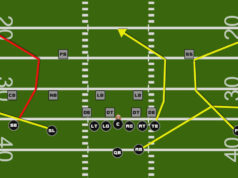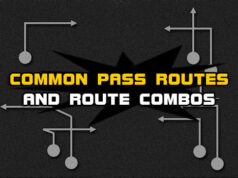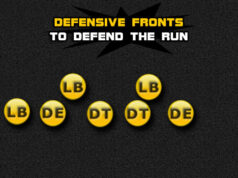Understanding the different types of pass coverages is essential when watching or playing football. In this X’s Os Football breakdown we take a look at common types of football pass coverages that you will encounter when watching and playing the game.
Cover 0
The first of type of pass coverage is Cover. Any type you here Cover 0, it means no safety help deep. Normally when this type of coverage is called the defense is bringing the heat on the QB. It’s a high risk/high reward coverage, meaning that you will get your share of big plays on defense such as sacks or interceptions, but you also will give up big plays from time to time. Most of Cover 0 coverages sends at least two defenders on a blitz. If you plan on running Cover 0, you will need to have a pair of shutdown corners who can cover their man in one on one coverage. If you have great stick control, you can get by with average corners.
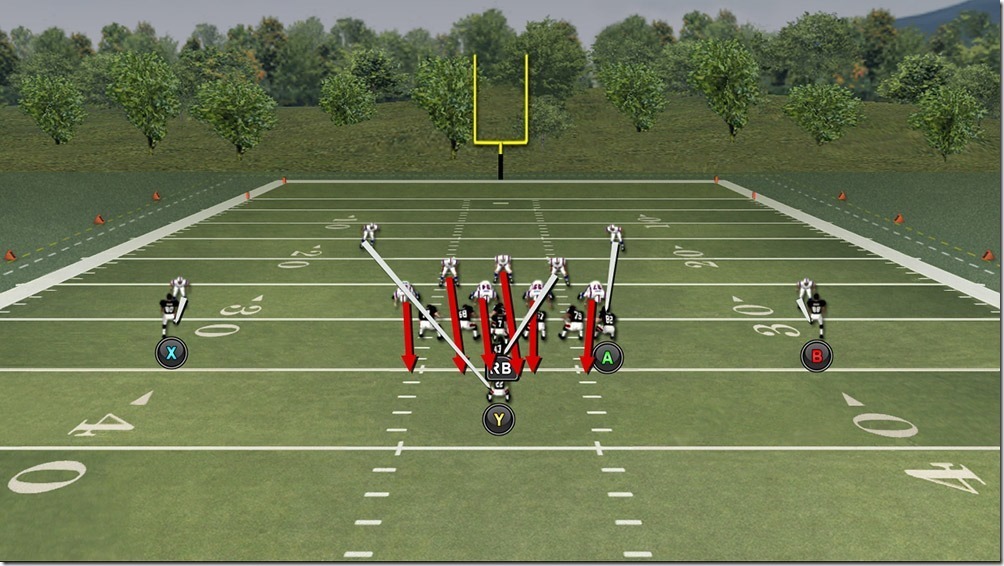
A typical Cover 0 defense you will fine has the FS and SS are in man coverage, along with three other defenders, while six defenders rush the quarterback.
Strengths:
- At the minimum it is a six man pass rush in most cases. At the most it can be an eight man pass rush.
- Quick pressure on the quarterback.,
- Effective versus play action passes.
- Effective versus roll outs and bootlegs when blitzing are coming from the outside.
Weaknesses:
- No center field or deep help from the safeties.
- Usually results in big plays if the pass rush fails.
- Must have excellent cornerbacks to be successful.
- Often difficult to disguise, especially when using press coverage.
When To Use:
Great call against the Spread offense or against QBs who can not beat the blitz.
Cover 1 (Man Free)
The Cover 1 defense is a man defense with one of the safeties playing back in deep middle zone coverage. This scheme is most successful when used by a team with good corners, or when playing against an offense whose wide receivers are overmatched by the corners. This is a very aggressive defense and dares the offense to get a pass off before the pass rush arrives. Generally the left corner takes the Flanker, the right corner the split end, the Strong Safety the Tight end, one linebacker blitzes while the remaining two take the running backs.
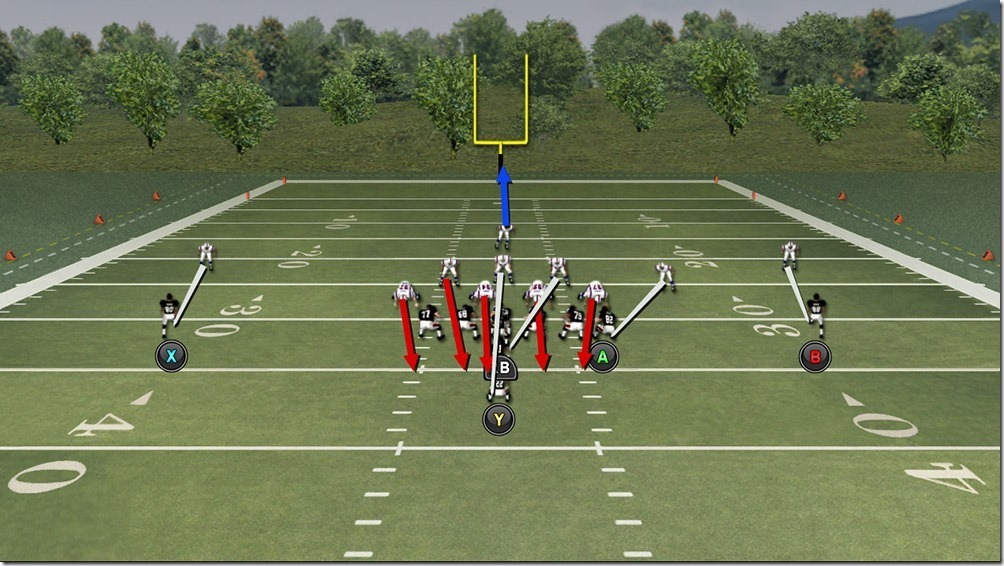
In the image above, the free safety covers the deep middle, while five defenders play man coverage. The four defensive linemen and a linebacker rush the quarterback.
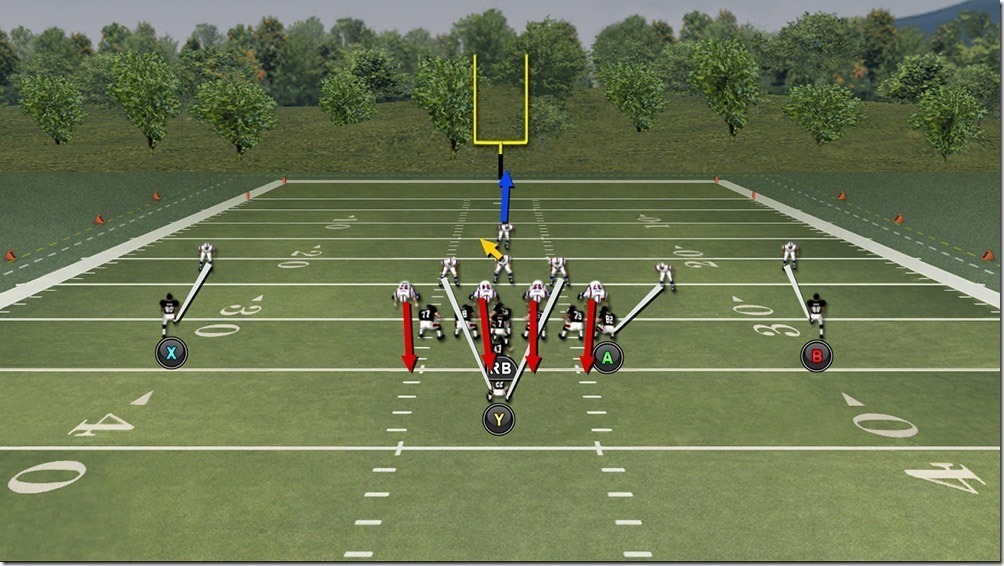
Another type of Cover 1 defense that you will find is Cover 1 Robber such as shown in the image above. The FS plays the deep middle of the field and MLB plays a hook zone.
Situational Use:
- Against teams that like to run Singleback
- Against the quarterback that takes deep drops
Strengths:
- Five man Pass Rush
- Help in the deep middle or towards one side of the field with the Safety.
- Effective against the run
- Effective versus play action.
- Effective versus roll out passes.
Weaknesses:
- Difficult to disguise.
- Swing passes out of the backfield could be tough to defend.
- Crossing concepts such as the double cross.
When to Use:
Great call in Goal line situations. Also the free Safety cannot help both corners, thus using this defense on the hash mark can be ideal as one corner can use the sideline for help.
Cover 2
The Cover 2 defense scheme is a 2 deep half field defense. Both safeties generally split the field in half, sideline to goalpost and prevent any receiver to get deeper then them. This scheme is normally used with teams that have slower corners and teams that are trying to defend the short passing game. This coverage forces the receivers into deep routes to the middle or the outsides of the field but in this time the pass rush should generate pressure or a sack on the Quarterback. There are two types of Cover 2. One is where the corners and linebackers play in man coverage and the one is where the corners and linebackers play in underneath zones. In football video games you will find a few Tampa Cover 2 defenses.The FS and SS split out wide, while a linebacker drops back over the deep middle.
Cover 2 Five Underneath Zone Coverage
The Cover 2 Zone is designed to give quick corner support against the run and to flood the five underneath passing zones with defenders in an attempt to stifle the short and intermediate passing attack. The cornerbacks generally funnel the outside receivers toward the inside with all of the pass defenders.
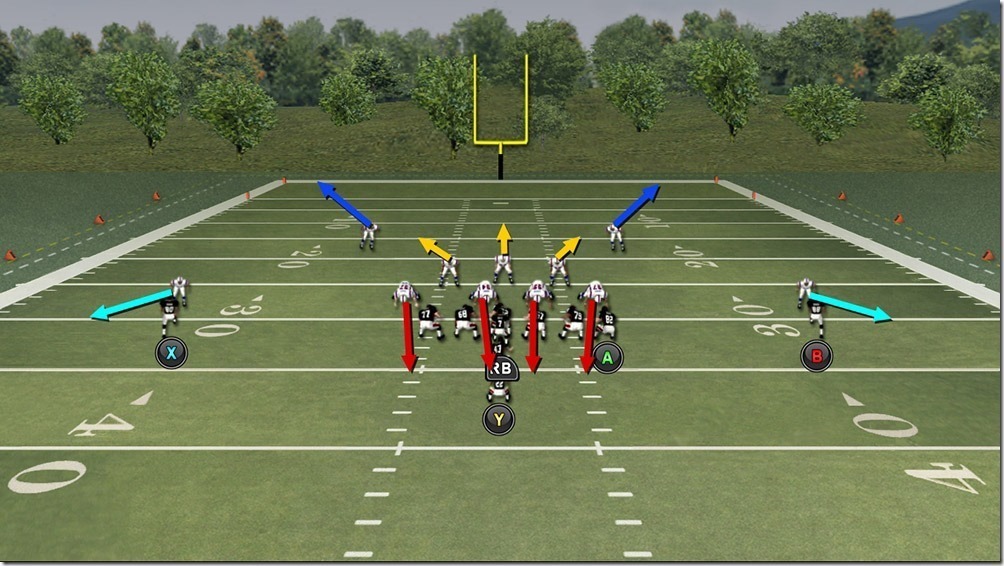
In the image above, we show a typical Cover 2 zone defense that drops both safeties in deep half zones. The three linebackers playbook hook zones underneath. The left and right cornerback play the flats.
Strengths:
- Strong against the intermediate and short passing game.
- The two deep Safeties converge on deep middle and outside passes.
Weaknesses:
- Multiple receiver sets (Trips, bunch) to one side of the field.
- Vertical passing concepts are very effective against Cover 2 zone.
- Not a lot of blitz schemes can be found from Cover 2 zone coverage.
- Relies on a 3 or 4 man pass rush to apply pressure on the quarterback.
When to Use:
It’s best to run when the offense gets inside of your 20 where the safeties don’t have cover as much ground, plus the cornerbacks in the flats may be able to help the safeties out if no receiver comes in their zone area.
Cover 2 Man Under
The Cover 2 Man Under is much like the Cover 2 Five Underneath Zone. The difference is man coverage underneath. The corners generally attempt to funnel the receivers outside.
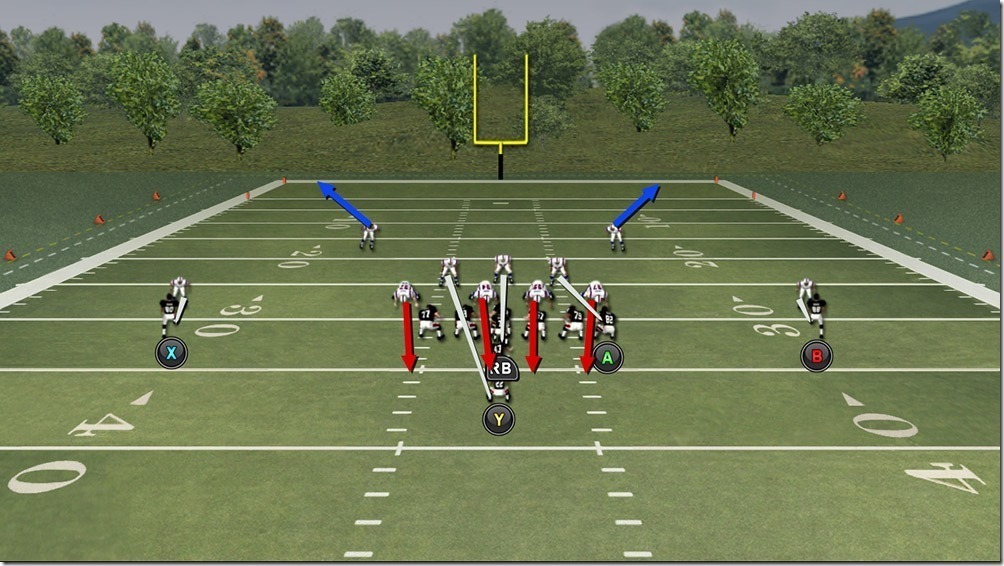
In the image above, there are five defenders in man coverage. The two safeties out wide and cover the deep halves of the field.
Strengths:
- Brackets on receivers running deep patterns.
- Solid inside run defense that allows 9 defenders to converge on the ball quickly.
- Looks identical to Cover 2 zone coverage.
- The most balanced defensive coverage in the game because all the receivers are covered, plus help over the top from the safeties.
Weaknesses:
- The play action pass pulls the linebackers in and opens up the middle of the field.
- Linebackers may be in a mismatch against backs out of the backfield.
- Relies on a 3 or 4 man pass rush to apply pressure on the quarterback.
When to Use:
Can be used in any situation. In football video games, Cover 2 Man Under is called 2 Man Under. Of all the defensive coverages in the games, the 2 Man Under is the most used because it’s flexibility.
Cover 3
The Cover 3 defense is a 3 deep scheme that has 3 defenders splitting the field in thirds, sideline to hash, hash to hash and the hash to side line. The base Cover 3 defense has both the outside corners in a deep 1/3 zone and the free safety in deep middle creating the 3 deep defender look. In the game this year, the majority of the heavy zone blitz packages or plays in the game are run with Cover 3 zones. This allows good coverage behind 8 men blitzes. You will from time to time encounter a Cover 3 where 1 cornerbacks and two safeties make up the coverage.
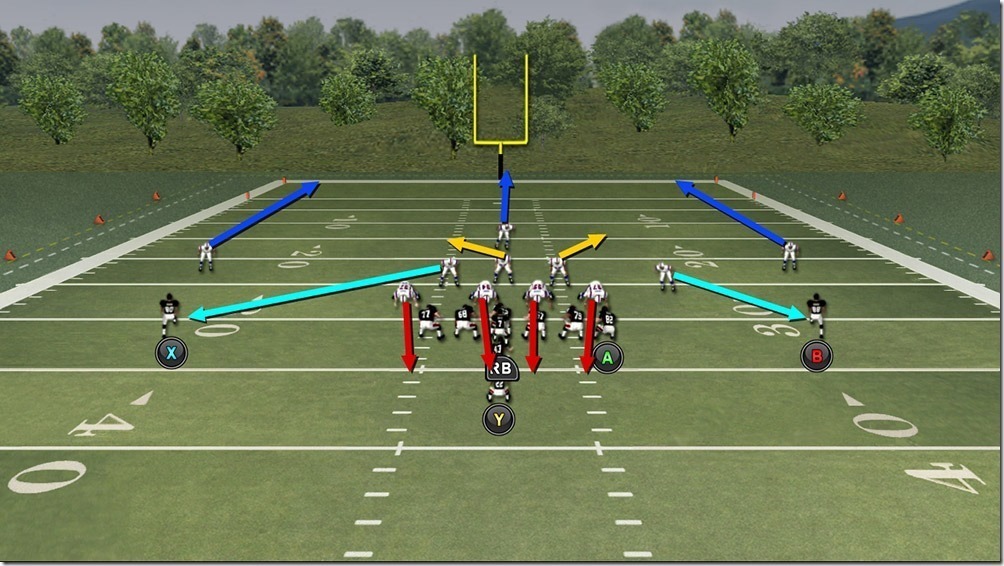
Cover 3 Sky coverage is a traditional Cover 3 defense that has the FS rotating over the deep middle, while the RCB and LCB drop back in deep zone coverage on both sides. The SS plays the flat (Sky). There are other types of Cover 3 coverages sound in the game such as Cloud and Roll Coverage. Many of the zone blitz schemes found in football video games can be found with Cover 3 coverage behind them.
Strengths:
- Three deep coverage makes it hard to pass deep.
- Strong run support from the strong safety against off tackle and the outside running game toward the strong side.
- The alignment of the Strong Safety allows for crash line stunts .
- Strong against crossing routes.
- Strong hash mark defense.
- Strong against corner routes ran by slot receivers or tight ends.
- Lots of zone blitz concepts.
Weaknesses:
- Flats are generally left wide open when zone blitz schemes are used with Cover 3 behind them.
- The zone can be stretched by sending multiple receivers vertically down the field.
- Flood concepts can easily be Cover 3 coverage.
- Relies on a 3 or 4 man pass rush to apply pressure on the quarterback.
When to Use:
Of all the types of zone coverages, Cover 3 is used the most. Most of top players will run because it can get pressure when blitzing, yet does a good job at covering pass in all areas of the field accept the flat areas.
Cover 4
Cover 4 defense is a four deep zone coverage. More often than not the corners drop straight back as well as the safeties not allowing any receiver to get deeper than them. Most teams use this type of coverage to prevent the deep ball or against an end of the half pass. In general the defense will allow the underneath patterns and never allow any route to be completed behind them. There two types of Cover 4 coverages, they are Man/Zone and Zone.
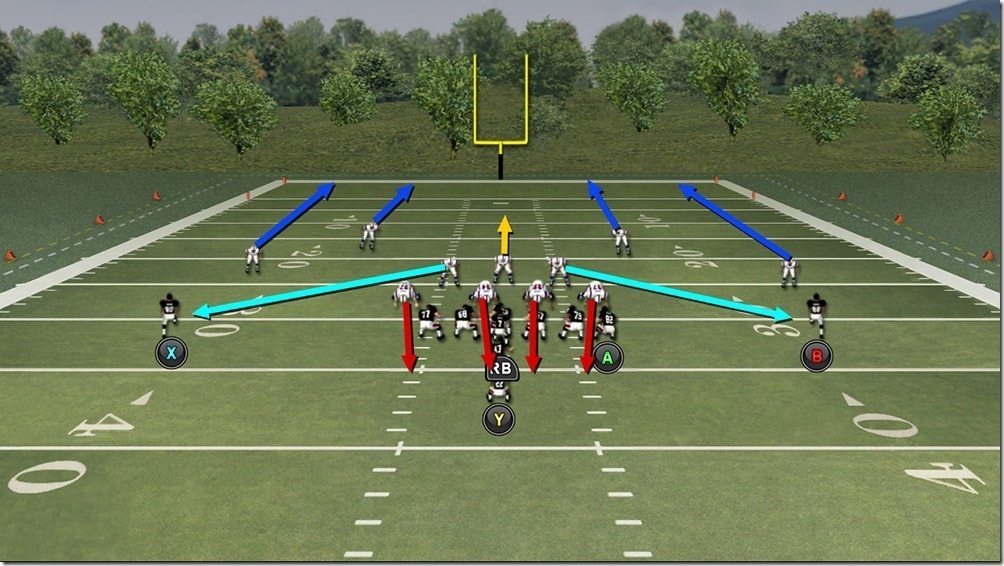
In the image about is common example of what a Cover 4 defense looks like when running a 4 man front. Four defenders play zone coverage underneath while four defenders dropping back in deep zone coverag3. Four other defenders rush the quarterback.
Strengths:
- Four defenders deep against the pass
- Safeties are in good position to converge on the inside run
- Balanced coverage on both sides of the defense
Weaknesses:
- Short passes – out route, hitches.
- Relies on a 3 or 4 man pass rush to apply pressure on the quarterback.
When to use:
End of the half or end of the game situations are a good time to pull out the Cover 4.
Cover 6
Cover 6 refers to three deep defenders, which looks like Cover 3. However, unlike Cover 3 the field is not split equally. The Cover 6 combines elements of the Cover 2 and the Cover 3. The position of the ball dictates strength of the offense.
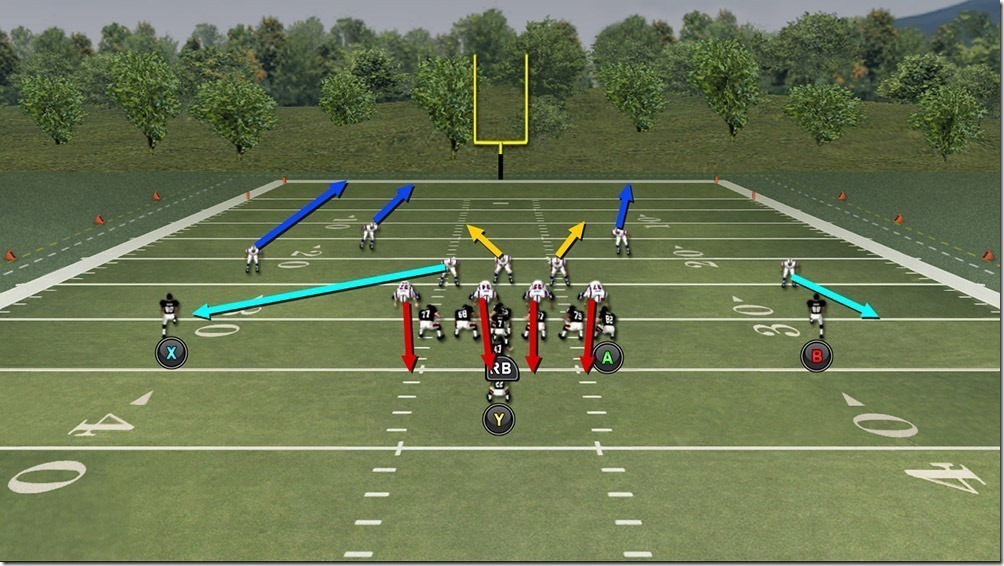
In Cover 6 the field safety and field corner cover fourths of the field, and depend on a field outside linebacker to support underneath them. The free safety covers the boundary-side deep half and the boundary corner plays the flat. Thus the field side of the coverage is quarters, and the boundary side is cover 2. A pro football team that has been known to run Cover 6 are the Steelers The quarters play of the strong side safety, like the Steelers’ Troy Polamalu, allows him to support on runs quickly.
Strengths:
- Cover 6 blends the best of Cover 2 and Cover 4.
- It provides good pass defense over the top.
- Does a good job against any vertical release by a 3rd receiver from the field side.
- The FS can play a hard read technique while reading the run first. He will fit hard and fast on run plays.If pass, he then will play vertical patterns/
- The right corner plays a quarters deep coverage and reads the split end or widest receiver to his side of the field. He plays all vertical and inside patterns.
Weaknesses:
- Cover 6 has the disadvantages of both Cover 2 and Cover 4.
- The field side is generally soft on flat coverage unless a defender drops in the curl to flat area.
- The field side corner can be left in single coverage deep as well.
- The boundary side is soft behind the corner to the sideline, as well as in the seam between corner and linebacker.
- Route combos such curl/flats or corner/streak are very effective the boundary side coverage.
When to use:
It all depends on where the ball is line up at. For instance in the image above, if the ball were placed on the right hash mark, you want to flip the defense. That way there is not as much room for ball to thrown in the flat area to the near side of the field. If the ball was throw to left (far side of the field) the RCB, would now play a hook zone and be in position to defend pass his area of the field.

